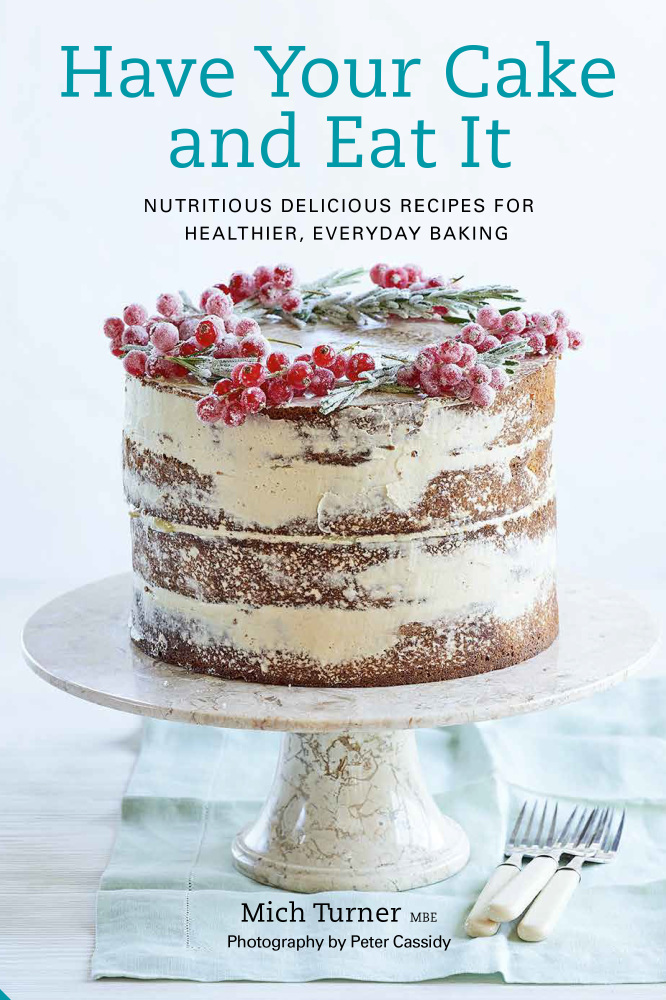Baking brings a huge amount of pleasure to the baker, the recipient and those sharing in the sweet treats – but how can you ensure your bakes are nutritious, delicious and healthier for everyday baking?

Mich Turner
Simple choices can help you make the most of your baking to improve your self confidence, skill and repertoire but at the same time ensure every bake looks impressive and tastes delicious being mindful of the nutritional content.
Butter is 80% fat – by switching to fresh cream (double is 48% fat and whipping cream is 35% fat) rather than buttercream to fill a Victoria sponge or Roulade you will be dramatically reducing the fat and sugar content of your bakes.
Meringues and pavlovas are gluten free and fat free. These bakes are impressive and serve well with fresh fruits. Serving these with cream will still have less fat than many other bakes.
Unrefined sugars will have more flavour than white refined sugars and as such you will be able to appreciate the enhanced flavour and not need to eat as much.
Root vegetables such as carrot, beetroot, parsnip and courgette will add fibre and natural sweetness to bakes as well as ensuring the bakes are deliciously moist.
Top these root vegetable bakes with a cream cheese frosting rather than buttercream. At 30% fat (cream cheese) rather than 80% fat (Butter) the frosting will be less calorific than regular buttercream
Make a fruit compote with berries, unrefined sugar and orange zest. The acidity and flavour of this intense fruit compote works wonderfully in place of jams made with 60% sugar layered in cakes, roulades or injected into muffins for a blast of flavour.
Naked cakes are an on trend. Skim coat a tall layered cake with buttercream made with unrefined icing sugar which will add a wonderful caramelised flavour rather than just sweetness. This can then be scraped back to ensure the cake is protected to keep the cake moist but not lathered in a thick coat of super sweet buttercream. Decorate with frosted rosemary and fresh fruits.
Add seeds, nuts and dried fruits to bakes to boost fibre, natural sweetness, texture and essential vitamins and minerals to your bakes – apricots, cashews and sunflower seeds are a great source of fibre and iron.
Add fresh fruits such as raspberries, peaches and apples to bakes to add flavour without the extra fat and sugar.
Roast nuts and use to decorate cakes and bakes – the flavour will be intensified and add great crunch.
If you are just starting out try some simple biscuits and flapjacks made with nut butters and oats – these will add flavour, texture and slow-release carbohydrates.
Flavour buttercreams and frostings with freeze dried fruit powders such as raspberry, blackcurrant, strawberry or cherry. The acidity and intensity combine well with the buttercreams and frostings to give an all natural – no added sugar, no artificial colours to your frostings.
For gluten free bakes try recipes with ground almonds, polenta, popcorn or gluten free oats and flavour well with fruit zests, spices or chocolate.
For a dairy free frosting consider a coconut frosting made with coconut oil, icing sugar, desiccated coconut and fresh lime zest – it’s like coconut ice in a frosting!
If you have a particularly sweet tooth, or low will power, make your favourite bakes but portion control them into small sizes.
Train your palate to appreciate a smaller quantity of the more intense flavours of these bakes rather than accepting a larger potion of sweet, salty, fatty bakes.
Thinking about the ingredients you are using and look to add the flavour and texture to your bakes by maximising these ingredients when they are in season.
Enjoy your baking – with these tips you can certainly “Have Your Cake and Eat It!”


